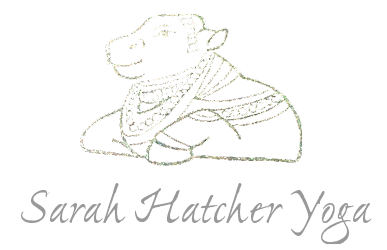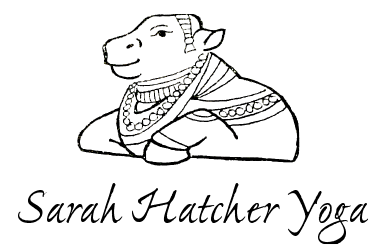The Misfits of Ashtanga
This past month I have been teaching heaps and meeting new yogis in the Aberdeen community, sharing a simple message: practice the misfit asanas, the challenging ones. Don't skip them.
If you practice every day, approach what you have been taught with genuine effort and the practice in turn will take you all the way towards understanding the last three limbs of ashtanga - dharana (concentration), dhyana (meditation), and samadhi (absorption).
Patanjali calls these last three limbs of ashtanga, a complete form of integration, Samyama.
The last three limbs come when there is no more wondering or questioning what we are doing in the asana. It is required that we have already done all our work and research and we are able to invite a quiet depth to seep into our practice.
If you are not practicing every day or very often, the misfit asanas will urge you to quit and fidget and fumble instead of experiencing samyama.
One of the ring leader misfits in the primary series - Janu Sirsasana C - is the posture that most people who are learning ashtanga simply skip. Others are a trifecta of difficult lotus-based asanas - Marichyasana B, D and Garbha Pindasana. These also get specifically left out because they are not easy, nor do they feel good for the first few years of practice.
Work on the difficult asanas that you may want to overlook. If we are incapable of disciplining ourselves to attempt the challenging asanas, then there is no way that we will understand samyama.
Without daily effort, how can we expect to advance or be more comfortable in the asanas that are alarming, if we don't go play with them every day?
Daily practice is the backbone of ashtanga yoga. Place practice as a priority over theory and study. You can do all the research you want - watch youtube and videos of pros all over, take workshops and go see famous yogis talk and demonstrate. But if you don't get on your mat and try, by yourself in your kitchen or in the Mysore room - samyama will definitely not happen.
I urge practitioners - whichever asana you are working on - first and foremost, try it every day. Why not spend a little bit more time working on what you are NOT good at and master that challenging misfit asana that is giving you grief? It may be giving you the right lesson you are needing to learn.
Patanjali outlines a perfect remedy for us on 'how-to' attain the riches of yoga. The crux of this method is practice: practice done for a long time, without a break, and with effort. If we can practice the feel-good asanas along WITH the misfit asanas with effort and with devotion, then one day we will understand all of the limbs of ashtanga yoga, including samyama.
Thank you Aberdeen, for inviting me to teach at the The Yoga Spot, Love Yoga, and at Mo Yoga. A huge thank you to Michele, Rebecca and Mo for inviting me into the community and giving me the opportunity to share my love for ashtanga. And may samyama seep into your practices, dear Aberdeen yogis! And to the yogis beyond Scotland, too!
*Teaching Update:
5 October Chanting and Philosophy class Yoga Spot - 10:30 am
Week-long Mysore intensive at Love Yoga October 14-18
Ashtanga Yoga Edinburgh week intensive October 21-25.
If you practice every day, approach what you have been taught with genuine effort and the practice in turn will take you all the way towards understanding the last three limbs of ashtanga - dharana (concentration), dhyana (meditation), and samadhi (absorption).
Patanjali calls these last three limbs of ashtanga, a complete form of integration, Samyama.
The last three limbs come when there is no more wondering or questioning what we are doing in the asana. It is required that we have already done all our work and research and we are able to invite a quiet depth to seep into our practice.
If you are not practicing every day or very often, the misfit asanas will urge you to quit and fidget and fumble instead of experiencing samyama.
One of the ring leader misfits in the primary series - Janu Sirsasana C - is the posture that most people who are learning ashtanga simply skip. Others are a trifecta of difficult lotus-based asanas - Marichyasana B, D and Garbha Pindasana. These also get specifically left out because they are not easy, nor do they feel good for the first few years of practice.
Work on the difficult asanas that you may want to overlook. If we are incapable of disciplining ourselves to attempt the challenging asanas, then there is no way that we will understand samyama.
Without daily effort, how can we expect to advance or be more comfortable in the asanas that are alarming, if we don't go play with them every day?
Daily practice is the backbone of ashtanga yoga. Place practice as a priority over theory and study. You can do all the research you want - watch youtube and videos of pros all over, take workshops and go see famous yogis talk and demonstrate. But if you don't get on your mat and try, by yourself in your kitchen or in the Mysore room - samyama will definitely not happen.
I urge practitioners - whichever asana you are working on - first and foremost, try it every day. Why not spend a little bit more time working on what you are NOT good at and master that challenging misfit asana that is giving you grief? It may be giving you the right lesson you are needing to learn.
Patanjali outlines a perfect remedy for us on 'how-to' attain the riches of yoga. The crux of this method is practice: practice done for a long time, without a break, and with effort. If we can practice the feel-good asanas along WITH the misfit asanas with effort and with devotion, then one day we will understand all of the limbs of ashtanga yoga, including samyama.
Thank you Aberdeen, for inviting me to teach at the The Yoga Spot, Love Yoga, and at Mo Yoga. A huge thank you to Michele, Rebecca and Mo for inviting me into the community and giving me the opportunity to share my love for ashtanga. And may samyama seep into your practices, dear Aberdeen yogis! And to the yogis beyond Scotland, too!
*Teaching Update:
5 October Chanting and Philosophy class Yoga Spot - 10:30 am
Week-long Mysore intensive at Love Yoga October 14-18
Ashtanga Yoga Edinburgh week intensive October 21-25.


